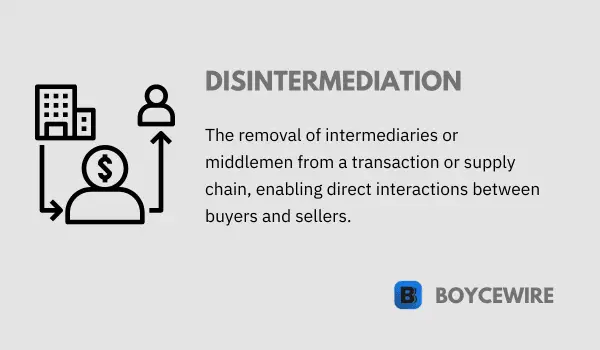Disintermediation: Definition, Causes, Effects & Examples

What is Disintermediation?
In a rapidly evolving digital world, traditional ways of doing business are being reshaped by emerging trends and technologies. One of the most transformative trends in this context is disintermediation. The term “disintermediation,” derived from the banking world, has expanded its relevance and application across various sectors, from finance to retail, and even media. The advent of the internet has been a significant catalyst for this phenomenon, eliminating the need for intermediaries and enabling direct interaction between producers and consumers.
Key Points
- Disintermediation is driven by technological advancements and the increasing popularity of online platforms that allow direct transactions between buyers and sellers.
- It eliminates the need for intermediaries, reducing transaction costs and potentially offering lower prices to consumers.
- Disintermediation can disrupt traditional business models and industries, as it challenges the role and value proposition of intermediaries.
Understanding Disintermediation
At its core, disintermediation is the removal or reduction of intermediaries or ‘middlemen’ in a supply chain or a transactional process. It typically happens when manufacturers or service providers decide to deal directly with end consumers, thereby eliminating the need for intermediaries such as wholesalers, brokers, agents, or retailers.
The term originated in the banking sector, referring to the practice of consumers bypassing traditional banks to invest directly in market securities. However, with the dawn of the digital age, the scope of disintermediation has broadened considerably. Today, it is a dominant force across various sectors, such as retail, travel, music, and publishing.
Technology plays a crucial role in this process. The rise of the internet and the proliferation of digital platforms have made it easier for businesses to connect directly with their customers, offering more tailored services and fostering direct relationships. These platforms have thus disrupted traditional supply chains and distribution channels.
It’s important to note that while disintermediation offers several advantages, such as cost reductions and more streamlined processes, it also brings new challenges. Businesses that choose to bypass intermediaries take on the responsibilities those intermediaries once held, such as customer service, logistics, and marketing. As such, a comprehensive understanding of disintermediation is essential for any business navigating the digital economy.
Causes of Disintermediation
- Technological Advancements The proliferation of the internet and digital technologies has made it easier for consumers to access goods and services directly from producers. E-commerce platforms, for instance, allow consumers to buy products directly from manufacturers.
- Cost Savings By eliminating intermediaries, businesses can often reduce costs, as they no longer need to share their profit margins with wholesalers, retailers, or agents. This can make their products or services more competitively priced, which can be an attractive proposition for consumers.
- Improved Customer Relationships Direct interaction with customers allows businesses to better understand their needs and preferences, leading to improved customer service and more customized offerings.
- Speed and Convenience Direct transactions can often be faster and more convenient than those that involve multiple intermediaries, particularly when these transactions are facilitated by online platforms.
- Transparency: With more information readily available online, consumers are becoming more knowledgeable about products and services. This increased transparency often leads consumers to deal directly with producers, thereby bypassing intermediaries.
- Control Over Brand Image When businesses deal directly with consumers, they have more control over their brand image and how their products or services are presented and marketed to the public.
It’s worth noting that while these factors can drive disintermediation, they can also pose challenges. For instance, businesses that choose to bypass intermediaries may need to invest in infrastructure, logistics, marketing, and customer service — functions that were previously handled by intermediaries.
Effects of Disintermediation
- Changes in Industry Structure As businesses bypass intermediaries and sell directly to consumers, traditional industry structures can be disrupted. This can lead to a reconfiguration of supply chains and distribution networks, and may also affect the balance of power within industries.
- Reduced Costs for Consumers By eliminating intermediary markups, disintermediation can potentially lower the cost of goods and services for consumers. This can increase consumer purchasing power and foster competitive pricing.
- New Business Opportunities Disintermediation often creates opportunities for new business models. For example, the rise of online platforms has enabled many small businesses and individual sellers to reach consumers directly, which would have been difficult in a traditional intermediary-based system.
- Challenges for Intermediaries For intermediaries, disintermediation can pose significant challenges. Unless they can adapt and offer added value that direct sellers cannot, they may find their roles becoming less relevant.
- Increased Responsibility for Businesses While disintermediation can bring benefits, it also places greater responsibility on businesses. They must now manage tasks previously handled by intermediaries, such as logistics, customer service, and marketing.
- Greater Market Transparency Disintermediation can increase market transparency, as consumers have more direct access to information about producers and their products. This can empower consumers to make more informed purchasing decisions, but it also places a greater onus on businesses to maintain high standards of product quality and customer service.
Overall, the effects of disintermediation can vary greatly depending on the specific industry, the nature of the products or services involved, and the degree to which businesses and intermediaries are able to adapt to these changes.
Advantages and Disadvantages of Disintermediation
Advantages
- Cost Reduction By eliminating the intermediaries, companies can reduce costs associated with commissions, fees, and other charges, which can lead to lower prices for consumers.
- Direct Interaction Companies can interact directly with their customers, allowing them to gain first-hand insight into consumer behavior, preferences, and feedback, which can aid in improving products and services.
- Increased Profit Margins By selling directly to consumers, businesses can potentially retain more of the profit margin that would otherwise have been shared with intermediaries.
- Speed and Efficiency Disintermediation often results in faster delivery of products or services as the number of steps in the distribution process is reduced.
Disadvantages
- Loss of Expertise Intermediaries often bring domain expertise, customer service, and post-sale services that businesses may struggle to provide.
- Increased Competition As barriers to entry decrease, companies may face increased competition from a larger number of direct-to-consumer sellers.
- Supply Chain Complexity Companies that bypass intermediaries often need to handle tasks such as distribution and customer service themselves, which can complicate their supply chain.
- Customer Overwhelm While more choice can be good, customers can also become overwhelmed by the sheer number of options available in a disintermediated market.
Understanding the advantages and disadvantages of disintermediation can help businesses make informed strategic decisions about their distribution channels and customer engagement strategies.
Examples of Disintermediation
- Online Retail Companies like Amazon and Alibaba serve as prominent examples of disintermediation. They allow producers to sell their products directly to consumers, bypassing traditional retail stores.
- Digital Music and Video Platforms like Spotify, Netflix, and YouTube have disintermediated traditional music and video distribution channels. Artists and creators can share their content directly with audiences, without the need for record labels or television networks.
- Travel and Accommodation Websites and apps like Airbnb, Booking.com, and Expedia allow property owners to rent out their properties directly to guests, bypassing traditional travel agents and hotel chains.
- Financial Services Online banking and investment platforms have enabled consumers to manage their finances without the need for traditional banks or brokers. Robo-advisors and P2P lending platforms are examples of this.
- Education Online learning platforms like Coursera, Udemy, and Khan Academy allow educators to reach students directly, bypassing traditional educational institutions.
These examples illustrate how disintermediation has disrupted traditional business models, leading to new ways of delivering products and services to consumers. It’s an ongoing process, as technology continues to evolve and create new opportunities for direct interaction between producers and consumers.
FAQs
Disintermediation refers to the process of eliminating intermediaries or middlemen in a transaction or supply chain, allowing direct interaction between buyers and sellers.
Examples of disintermediation include online marketplaces that connect buyers and sellers directly, bypassing traditional brick-and-mortar retailers, as well as digital platforms that allow consumers to access goods and services without the need for intermediaries.
Disintermediation is often driven by technological advancements, such as the internet and e-commerce, which enable direct interactions and transactions. It can also be motivated by the desire to reduce costs, increase efficiency, and provide greater convenience to consumers.
Disintermediation can lead to lower prices for consumers, as it eliminates the markups imposed by intermediaries. It can also foster competition, innovation, and market access for smaller businesses and entrepreneurs.
About Paul
Paul Boyce is an economics editor with over 10 years experience in the industry. Currently working as a consultant within the financial services sector, Paul is the CEO and chief editor of BoyceWire. He has written publications for FEE, the Mises Institute, and many others.

Further Reading
 Gini Coefficient: Definition, How to Calculate & Formula - Simply put, the Gini coefficient is a statistical measure used to calculate inequality within a nation.
Gini Coefficient: Definition, How to Calculate & Formula - Simply put, the Gini coefficient is a statistical measure used to calculate inequality within a nation.  The Importance of Free Trade - True free markets don’t exist anywhere in the world. This is because free markets and free trade go hand in…
The Importance of Free Trade - True free markets don’t exist anywhere in the world. This is because free markets and free trade go hand in…  Intangible Assets: Definition, Types & Example - An intangible asset is not physical in presence. It cannot be seen or touched.
Intangible Assets: Definition, Types & Example - An intangible asset is not physical in presence. It cannot be seen or touched. 